[推荐学习]七年级英语上册Unit6Let’sGoLesson32AttheSupermarket练
- 格式:doc
- 大小:287.00 KB
- 文档页数:7
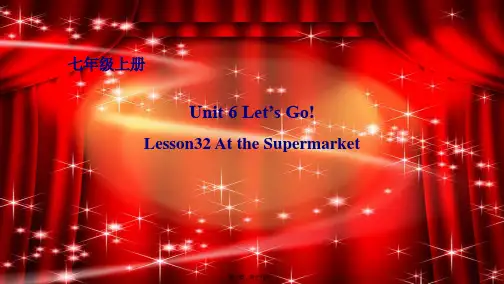
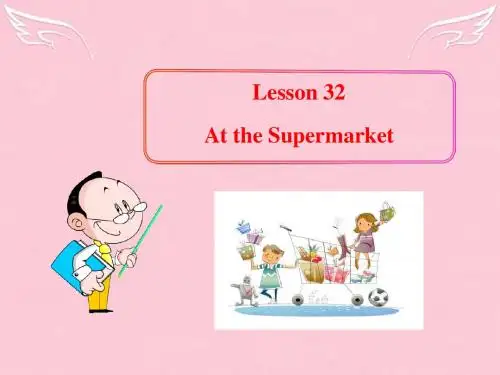
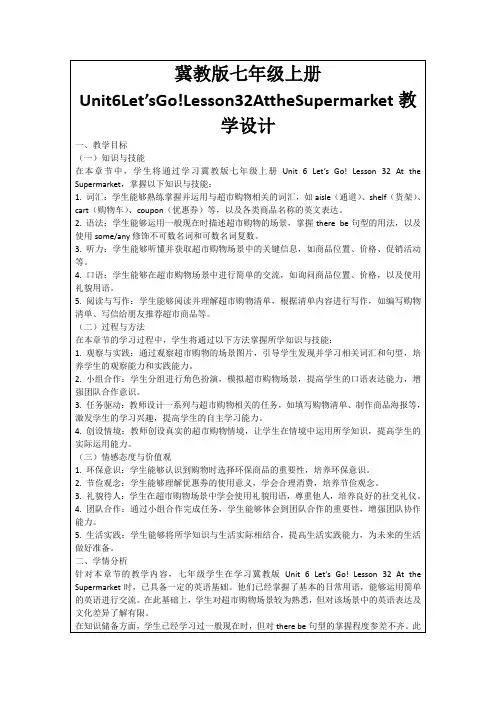
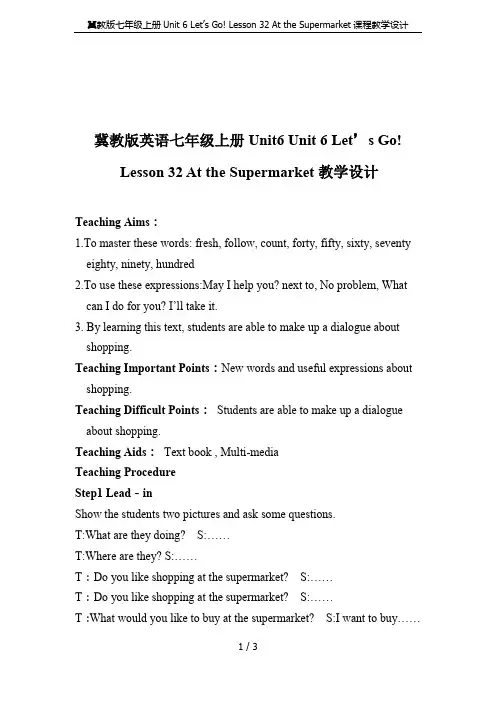
冀教版英语七年级上册Unit6 Unit 6 Let’s Go!Lesson 32 At the Supermarket教学设计Teaching Aims:1.To master these words: fresh, follow, count, forty, fifty, sixty, seventy eighty, ninety, hundred2.To use these expressions:May I help you? next to, No problem, What can I do for you? I’ll take it.3. By learning this text, students are able to make up a dialogue about shopping.Teaching Important Points:New words and useful expressions about shopping.Teaching Difficult Points:Students are able to make up a dialogue about shopping.Teaching Aids:Text book , Multi-mediaTeaching ProcedureStep1 Lead-inShow the students two pictures and ask some questions.T:What are they doing? S:……T:Where are they? S:……T:Do you like shopping at the supermarket? S:……T:Do you like shopping at the supermarket? S:……T:What would you like to buy at the supermarket? S:I want to buy……In a word,We can buy almost everything. OK. Now let’s study lesson32. Step2 Learning new text1.Vocabulary learningCheck the New Words:Use the new words to fill in the blanks.2.ListeningFinish Let’s do it: Part1.What do Li Ming and his mother want to buy? Listen and match the pictures.3.Reading(1)Where are Li Ming and his mum?(2)Where are the potatoes?(3)How much is the red T-shirt?nguage Points(1)They are next to the carrots. 它们挨着胡萝卜。
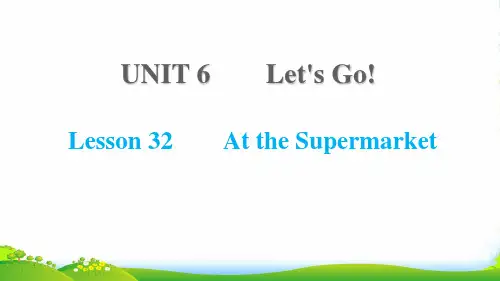
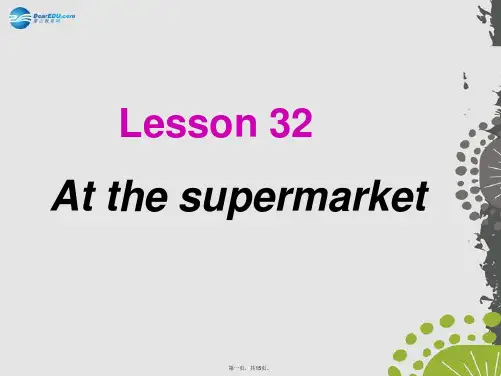
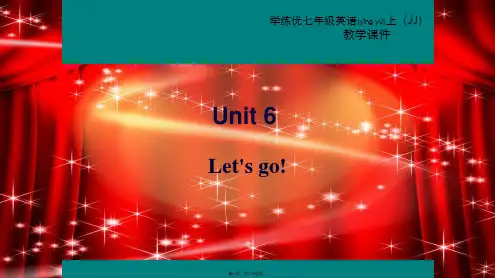
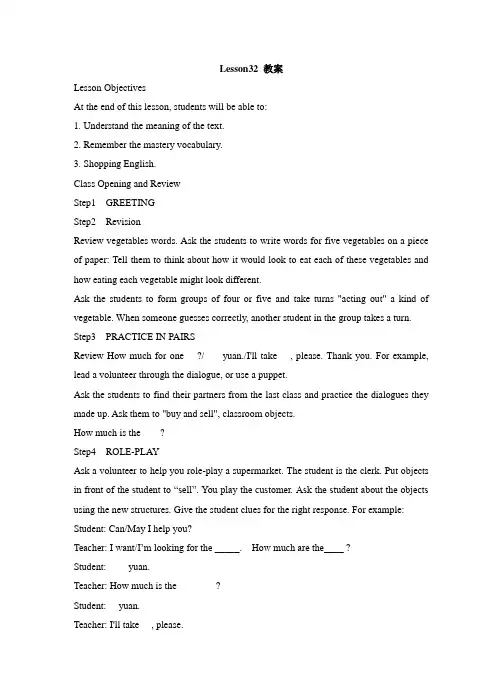
Lesson32 教案Lesson ObjectivesAt the end of this lesson, students will be able to:1. Understand the meaning of the text.2. Remember the mastery vocabulary.3. Shopping English.Class Opening and ReviewStep1 GREETINGStep2 RevisionReview vegetables words. Ask the students to write words for five vegetables on a piece of paper: Tell them to think about how it would look to eat each of these vegetables and how eating each vegetable might look different.Ask the students to form groups of four or five and take turns "acting out" a kind of vegetable. When someone guesses correctly, another student in the group takes a turn. Step3 PRACTICE IN PAIRSReview How much for one __?/ ___yuan./I'll take __, please. Thank you. For example, lead a volunteer through the dialogue, or use a puppet.Ask the students to find their partners from the last class and practice the dialogues they made up. Ask them to "buy and sell", classroom objects.How much is the____?Step4 ROLE-PLAYAsk a volunteer to help you role-play a supermarket. The student is the clerk. Put objects in front of the student to “sell”. You play the customer. Ask the student about the objects using the new structures. Give the student clues for the right response. For example: Student: Can/May I help you?Teacher: I want/I’m looking for the _____. How much are the____ ?Student: ____yuan.Teacher: How much is the_____ ?Student:__ yuan.Teacher: I'll take __, please.Student: (Give you the object or objects. )Teacher: Thanks!Student: You're welcome.Teaching TipRemember, students need lots of praise for trying. In North American classrooms, teachers often encourage their classes to applaud a good try.Write the structures on the blackboard or post the words in pocket panels on the wall. Show the students that you say How much are for more than one thing and How much is for one thing. Point to each structure and ask a volunteer to suggest a food or object in the correct form that could fit the blank.Step5 NumbersCan you read numbers?Can you find the rules(规律)?Count with the students from one to thirty. When you get to thirty, continue counting and encourage the students to count with you up to thirty-nine.Show the students how the pattern for thirty-one to thirty-nine is the same as for twenty-one to twenty- nine. Write twenty and thirty on the blackboard. Point to the words as you and the students say them a few times.Add a hyphen after each word and tell the students to count with you. Take the word-cards for one to nine that you prepared for this unit and hold them up in sequence after twenty-, and then thirty-, as you and the students count.Write forty, fifty, sixty, seventy, eighty, ninety and one hundred on the blackboard. Translate if necessary. Point to the words as you and the students say them a few times. Explain that you count from these numbers the same way as you count up from twenty and thirty. Demonstrate once with the word- cards. Point out the similarity between forty and four, fifty and five and so on.Step6 ListeningPlay the recording as they follow along in their books.Step7 Role-playStep8 Let’s do itClass ClosingHere are the homework recommendations for this lesson: .The remaining activities in the Let’s do it.The next reading in the student bookMake up a dialogue.。
Unit 6 Let's Go!
At the Supermarket
Lesson 32
●1 next to紧邻;挨着
[观察] They are next to the carrots.它们挨着胡萝卜。
I sit next to my good friend.我和我的好朋友挨着坐着。
[探究] next to意为“紧邻;挨着”,相当于beside。
活学活用
1.萨拉正坐在窗户旁边。
Sarah is sitting ________ ________ the window.
●2 follow v. 跟随;明白
[观察] Please follow me. 请跟我来。
Sorry, I can't follow you.
对不起,你说的我没有理解。
[探究] (1)follow为及物动词,意为“跟随,在……之后”,后接名词或代词作宾语。
(2)follow还可以译为“理解”。
活学活用
2.—Where is the hotel?
—It's over there ________ me, please.
A.Help B.Follow
C.Show D.Stop
●3 hundred num. 百
[观察] I have only two hundred yuan.
我仅有两百块钱。
There are hundreds of people in the hall.
大厅里有数百人。
[探究] (1)hundred (百), thousand (千)和million (百万)等在表示具体的数量时,用________形式。
例如:
five hundred 五百nine thousand 九千
(2)hundred, thousand, million 等表示约数时,与of 连用,并且用复数形式。
例如:
hundreds of people 数百人
thousands of students 数千名学生
millions of farmers 数百万农民
活学活用
3.It's reported(据报道) that people throw ________ plastic bags along this street every day.
A.hundred
B.hundreds
C.hundred of
D.hundreds of
● 1 I'll show you!我将指给你!
[探究] (1)show作动词,意为“带领;引导;指路”。
show sb. around意为“带领某人参观”。
例如:
Thank you for showing me around your school.
谢谢你带领我参观你们的学校。
(2)show作动词,意为“给……看”。
show sb. sth.=show sth. to sb.,意为“把某物出示给某人看”。
例如:
Can you show me your photos?
=Can you show your photos to me?
你能把你的照片给我看看吗?
[拓展] show 还可以作名词,意为“展览;节目;演出”。
例如:
The Spring Festival Gala is a very popular TV show.
《春节联欢晚会》是一档非常受欢迎的电视节目。
活学活用
1.(1)你能指给我去学校的路吗?
Can you ________ me ________ ________ to the school?
(2)今晚在央视八套有一个访谈节目。
There is a ________ ________ on CCTV 8 this evening.
●2 OK, I will take it. 好的,我买(这件)了。
[探究] 动词take在句中译为“买”,后接名词或代词作宾语,相当于________。
在口语中,当顾客决定购买某商品时,通常说“I'll take it.”,而不说“I'll buy it.”。
例如:
He will take the three books.
他将要买这三本书。
活学活用
2.我将要买两瓶水。
I ________ ________ two bottles of water.
详解详析
【课前自主预习】
单词闯关
1.fresh
2.follow
3.count
4.forty 5.fifty 6.sixty 7.seventy 8.eighty 9.ninety 10.hundred
短语互译
1.在超市 2.没问题;别客气 3.over there 4.next to
句型在线
1.wants to buy 2.am looking for 3.What can; for 4.will take it 5.Count with
【课堂互动探究】
词汇点睛
●1 next to
●2 B
●3 单数 D
句型透视
●1 (1)show; the way (2)talk show
●2 buy will take/buy
【课时分层训练】
课内基础自测
Ⅰ.1.fresh 2.follow 3.counting
4.eighty 5.hundred
Ⅱ.1.are shopping at 2.next to
3.What can 4.No problem
5.How much
课后巩固提升
Ⅰ.1.B look for意为“寻找”,强调找的过程;find意为“发现”,强调找的结果。
句意:莉莉正在找她的钢笔,但是她没有找到。
2.C
3.C 此题考查在商店购物时的交际用语。
“What can I do for you?”相当于“Can I help you?”意为“你想买点什么?”
4.B 5.C
6.C show sth.to sb.意为“向某人展示某物;给某人看某物”,是固定短语。
7.D some用于肯定句;any用于表示疑问语气的疑问句。
8.D 句意:作为学生我们应该遵守校规。
follow意为“跟随”,符合题意。
Ⅱ.1.C根据“The strawberries are very nice. Mother likes them very much and buys some for herself.”可知妈妈非常喜欢草莓,故选C。
2.B 根据“Mother likes red apples, but the apples in the supermarket are green. We don't buy them.”可知妈妈没有买苹果,故选B。
3.D 根据“The oranges are very nice, too. Mother buys some for me.”可知答案选D。
4.D 由文中“…but the apples in the supermarket are green. We don't buy them.”可知答案为D。
5.D 由文中“We buy some broccoli…my parents like it.”可知答案为D。